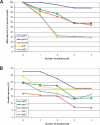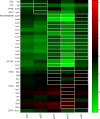Identification of genome-scale metabolic network models using experimentally measured flux profiles
- PMID: 16839195
- PMCID: PMC1487183
- DOI: 10.1371/journal.pcbi.0020072
Identification of genome-scale metabolic network models using experimentally measured flux profiles
Abstract
Genome-scale metabolic network models can be reconstructed for well-characterized organisms using genomic annotation and literature information. However, there are many instances in which model predictions of metabolic fluxes are not entirely consistent with experimental data, indicating that the reactions in the model do not match the active reactions in the in vivo system. We introduce a method for determining the active reactions in a genome-scale metabolic network based on a limited number of experimentally measured fluxes. This method, called optimal metabolic network identification (OMNI), allows efficient identification of the set of reactions that results in the best agreement between in silico predicted and experimentally measured flux distributions. We applied the method to intracellular flux data for evolved Escherichia coli mutant strains with lower than predicted growth rates in order to identify reactions that act as flux bottlenecks in these strains. The expression of the genes corresponding to these bottleneck reactions was often found to be downregulated in the evolved strains relative to the wild-type strain. We also demonstrate the ability of the OMNI method to diagnose problems in E. coli strains engineered for metabolite overproduction that have not reached their predicted production potential. The OMNI method applied to flux data for evolved strains can be used to provide insights into mechanisms that limit the ability of microbial strains to evolve towards their predicted optimal growth phenotypes. When applied to industrial production strains, the OMNI method can also be used to suggest metabolic engineering strategies to improve byproduct secretion. In addition to these applications, the method should prove to be useful in general for reconstructing metabolic networks of ill-characterized microbial organisms based on limited amounts of experimental data.
Conflict of interest statement
Figures



Similar articles
-
Integration of enzymatic data in Bacillus subtilis genome-scale metabolic model improves phenotype predictions and enables in silico design of poly-γ-glutamic acid production strains.Microb Cell Fact. 2019 Jan 9;18(1):3. doi: 10.1186/s12934-018-1052-2. Microb Cell Fact. 2019. PMID: 30626384 Free PMC article.
-
Estimating Metabolic Fluxes Using a Maximum Network Flexibility Paradigm.PLoS One. 2015 Oct 12;10(10):e0139665. doi: 10.1371/journal.pone.0139665. eCollection 2015. PLoS One. 2015. PMID: 26457579 Free PMC article.
-
Genome-scale in silico models of E. coli have multiple equivalent phenotypic states: assessment of correlated reaction subsets that comprise network states.Genome Res. 2004 Sep;14(9):1797-805. doi: 10.1101/gr.2546004. Genome Res. 2004. PMID: 15342562 Free PMC article.
-
Metabolic fluxes and beyond-systems biology understanding and engineering of microbial metabolism.Appl Microbiol Biotechnol. 2010 Nov;88(5):1065-75. doi: 10.1007/s00253-010-2854-2. Epub 2010 Sep 7. Appl Microbiol Biotechnol. 2010. PMID: 20821203 Review.
-
Flux analysis and metabolomics for systematic metabolic engineering of microorganisms.Biotechnol Adv. 2013 Nov;31(6):818-26. doi: 10.1016/j.biotechadv.2013.05.002. Epub 2013 May 13. Biotechnol Adv. 2013. PMID: 23680193 Review.
Cited by
-
A dual-scale fused hypergraph convolution-based hyperedge prediction model for predicting missing reactions in genome-scale metabolic networks.Brief Bioinform. 2024 Jul 25;25(5):bbae383. doi: 10.1093/bib/bbae383. Brief Bioinform. 2024. PMID: 39101499 Free PMC article.
-
Genetic basis and detection of unintended effects in genetically modified crop plants.Transgenic Res. 2015 Aug;24(4):587-603. doi: 10.1007/s11248-015-9867-7. Epub 2015 Feb 26. Transgenic Res. 2015. PMID: 25716164 Free PMC article. Review.
-
A gap-filling algorithm for prediction of metabolic interactions in microbial communities.PLoS Comput Biol. 2021 Nov 1;17(11):e1009060. doi: 10.1371/journal.pcbi.1009060. eCollection 2021 Nov. PLoS Comput Biol. 2021. PMID: 34723959 Free PMC article.
-
Systematic applications of metabolomics in metabolic engineering.Metabolites. 2012 Dec 14;2(4):1090-122. doi: 10.3390/metabo2041090. Metabolites. 2012. PMID: 24957776 Free PMC article.
-
Linking genome-scale metabolic modeling and genome annotation.Methods Mol Biol. 2013;985:61-83. doi: 10.1007/978-1-62703-299-5_4. Methods Mol Biol. 2013. PMID: 23417799 Free PMC article.
References
-
- Price ND, Reed JL, Palsson BO. Genome-scale models of microbial cells: Evaluating the consequences of constraints. Nat Rev Microbiol. 2004;2:886–897. - PubMed
-
- Vo TD, Greenberg HJ, Palsson BO. Reconstruction and functional characterization of the human mitochondrial metabolic network based on proteomic and biochemical data. J Biol Chem. 2004;279:39532–39540. - PubMed
-
- Bonarius HPJ, Schmid G, Tramper J. Flux analysis of underdetermined metabolic networks: The quest for the missing constraints. Trends Biotechnol. 1997;15:308–314.
Publication types
MeSH terms
Grants and funding
LinkOut - more resources
Full Text Sources

